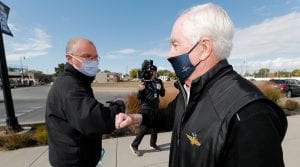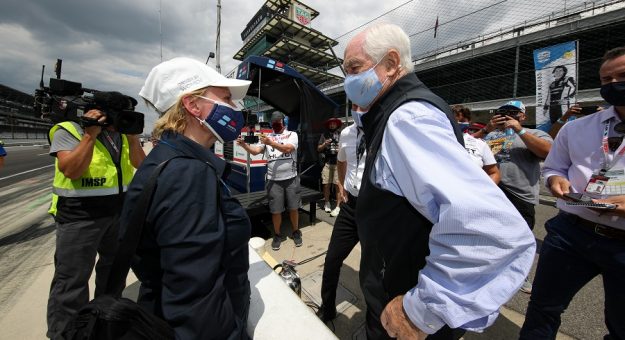INDIANAPOLIS – Now that Roger Penske has added the additional responsibilities as owner of the Indianapolis Motor Speedway, the Indianapolis 500 and IndyCar to his global business empire and the most successful racing operation in history, he admits that “every night is stressful to me.”
But Saturday night was extra stressful.
Two of his entries were not locked into the starting lineup for the 105th Indianapolis 500. That included 2018 Indy 500 winner Will Power, one of the great pole winners in IndyCar history with 62. That’s second to Mario Andretti’s record of 67.
The other entry was Simona De Silvestro, who drives a Team Penske car and has an engineering alliance and Team Penske crewmembers in key positions with Paretta Autosport and its mostly female operation.
Power and De Silvestro were among five drivers that had to get into the race through the Last Row Shootout Sunday. They joined Sage Karam of Dreyer & Reinbold Racing, Charlie Kimball of AJ Foyt Racing and RC Enerson of Top Gun Racing in the battle for the final three positions.
Karam easily got in and will start on the inside of the 11th row. Power brushed the turn two wall on his four-lap qualification attempt on Sunday but stayed in the throttle and will start 32nd in the 33-car field. De Silvestro qualified fast enough to make the field and will start last in Sunday’s 105th Indy 500.
For Roger Penske, the owner and promoter of the Indianapolis 500, he had ticket-selling drama. For Penske, the winningest team owner in Indy 500 history, it was a bit more drama that he would have liked.
“Every night is stressful to me,” Penske said in response to a question from SPEED SPORT as a small gathering of reporters caught him on pit lane. “We were here in 1995 and had a similar situation. When you look at the chances and see where we were and after, I felt a lot better after I saw us run this morning and that was the key. We finally got a balance in the car she was comfortable with. Her time on Saturday was consistent, even though it wasn’t fast. They had the wrong gears in it.
“Hey, it’s over. Let’s get ready for the race.”
Penske admitted that when Power brushed the turn two wall on his qualification attempt and “white walled” his Firestone Tires, he was concerned. But Power is a true racer and never lifted off the accelerator.
“When Will brushed the wall in turn two, I didn’t know if that was going to kill the run. It hurt the speed, but he never lifted,” Penske said. “That is what it’s all about – you can never lift.”
Rookie driver Scott McLaughlin is the highest-starting Team Penske driver in the 33-car field as Penske attempts to win the Indy 500 for the 19th time as a team owner. But McLaughlin starts 17th, the middle of row six, in the No. 3 Pennzoil Chevrolet. Josef Newgarden starts on the outside of row seven and Simon Pagenaud is mired in the middle of row nine.
Power and De Silvestro will bring up the rear of the field.
“We’re going to have to have some luck, we’re going to have to have some real good strategy,” Penske explained of the path to winning Sunday’s race. “We’re going to have to work really hard to get to the front. We’ve been running strong until they turned the boost up. Our race setup seems to be good. It’s going to warm and it’s going to be slippery so we will see.
“Juan Pablo Montoya won this race from the back in 2015. Getting in the race was the first thing we had to do, and we were able to do that. The format is great. The fact they can go back out [and] the way the fans reacted for Simona. Having a woman in this race was one of my No. 1 goals after last year when we didn’t have fans at the race. That’s one thing I couldn’t feel better about.”
Four-time Indianapolis 500 winning driver Rick Mears has always described the Indianapolis 500 as two races. The first is for the pole and the second and most important happens on race day in the battle to be first after 500 miles.
Qualifications are complete and Team Penske didn’t win the pole, but the big prize comes on May 30.

Penske already sees some success as the new owner of the Indianapolis Motor Speedway.
“It’s one of the reasons I’m here is to see us win the race,” Penske said. “On the other hand, the race I saw on qualification day on Saturday with all the people, the reports we’re getting is we have had as many people as we had in 2016. That’s pretty good. We’re getting young people. Look in the stands, you see so many young people. This is generational in terms of families and friends. We just have to carry on that legacy.
“Saturday was the best Saturday we’ve had since 2016. In a world that is upside-down with COVID, I would say we made some great progress.”
Scott Dixon won his fourth Indy 500 pole and it’s the fastest field in Indy 500 history with a field average of 230.294 miles per hour.
This is the third-closest field in Indianapolis 500 history, by time. The gap between pole winner Scott Dixon and slowest qualifier Dalton Kellett is 2.288 seconds. The record is 1.8040 seconds between pole winner Simon Pagenaud and slowest qualifier Kyle Kaiser in 2019. The second-closest gap is 2.1509 seconds, in 2014.
It’s the sixth-closest field in history, by speed.
With Dixon (40), Colton Herta (21) and Rinus VeeKay (20) having an average age of 27, it is not the youngest front row in Indy 500 history. That remains 1930, when Billy Arnold (24), Louis Meyer (25) and Shorty Cantlon (26) averaged 25 years old. The front rows in 1932 and 2013 averaged 26.3 years, and the 1931, 1966 and 2021 front rows averaged 27 years of age.
Penske remains quite pleased, however, with the younger trend in this year’s 500 field and the younger crowds that are arriving at the Indianapolis Motor Speedway.
“The young drivers, these kids start early in go-karts,” Penske said. “The fact we had testing here in early April and we two oval races to start to the month at Texas. It’s been safe; it’s been fast and it’s been competitive. That is what we want. When we came here in the 1960s and 1970s, you had to run at Phoenix and you had to run at Trenton before you could even show up here. This is a little bit of the same.
“It’s over. Now, let’s go racing.”
